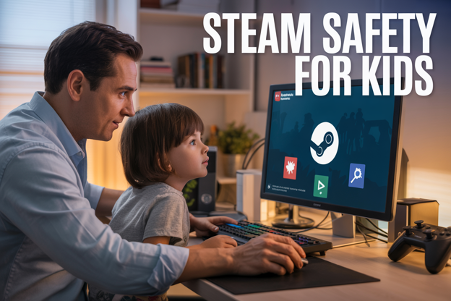Steam is a popular gaming platform for kids and teens, but parents often question its safety for children. This guide is for parents who want to understand Steam’s risks and benefits while learning how to protect their kids online.
Steam offers thousands of games, from educational puzzles to mature-rated titles with violence and inappropriate content. While the platform includes built-in safety features, it also presents risks like exposure to unsuitable games, online predators through chat functions, and unmonitored spending on game purchases.
We’ll explore Steam’s existing parental controls and examine how third-party monitoring tools like TheOneSpy, Qustodio, Bark, and Family Link can provide additional protection. You’ll also discover practical steps for setting up effective controls and creating a safer gaming environment for your children.
Table of Contents
Understanding Steam’s Safety Features and Age-Appropriate Content
Steam’s built-in parental controls and family sharing options
Steam provides comprehensive family features through Steam Family View and Family Sharing. Family View restricts access to age-inappropriate games, community features, and the Steam store, requiring a PIN for any restricted activities. Family Sharing allows parents to share their game library with up to five family members while maintaining control over which games children can access.
Age rating systems and content filtering mechanisms
Steam displays ESRB, PEGI, and other regional ratings prominently on game pages, helping parents make informed decisions. The platform’s content filtering system allows automatic hiding of games based on violence, nudity, or mature themes. Parents can customize these filters to match their family’s comfort level and values.
Community features and their potential risks for children
Steam’s social features include friend requests, group chats, voice communication, and user-generated content sharing. These features can expose children to inappropriate conversations, cyberbullying, or contact with strangers. The community marketplace also presents risks through scams and unsafe trading practices that target younger users.
Privacy settings and account security measures
Steam offers robust privacy controls allowing parents to restrict profile visibility, friend requests, and trading capabilities. Two-factor authentication adds security layers, while email notifications alert parents to account changes. Parents can disable community features entirely or limit interactions to friends-only for maximum protection.
Identifying Key Risks Parents Should Know About Steam

Exposure to inappropriate content and violent games
Steam’s massive game library contains thousands of titles with mature themes, graphic violence, and explicit content that can easily reach young users. The platform’s age verification system relies on simple date entry, making it trivial for children to access M-rated games featuring intense combat, sexual themes, and disturbing imagery.
Online predators and unsafe communication channels
Steam’s chat features, friend requests, and community forums create multiple avenues for strangers to contact children. Predators often use gaming as a gateway to build trust with young players, moving conversations from Steam to private messaging apps where parental oversight disappears completely.
Excessive gaming and addiction concerns
Steam’s achievement systems, trading cards, and social features are specifically designed to keep players engaged for extended periods. Children can easily lose track of time, neglecting homework, sleep, and real-world relationships while chasing virtual rewards and maintaining their online gaming status.
In-game purchases and financial risks
Steam Wallet integration and one-click purchasing make spending money dangerously simple for children. Games with microtransactions, cosmetic items, and loot boxes can result in hundreds of dollars in unexpected charges, especially when payment information is saved to accounts.
Top Parental Control Solutions for Steam Monitoring
TheOneSpy comprehensive gaming surveillance features
TheOneSpy stands out as a powerful monitoring solution that tracks Steam activity across multiple devices. The platform captures detailed gaming sessions, including time spent on specific games, chat conversations, and friend interactions. Parents can access comprehensive reports showing which games their children play, how long they spend gaming, and who they communicate with during sessions.
The software operates invisibly in the background, recording screen activity and keystrokes without alerting the user. This stealth functionality allows parents to monitor authentic gaming behavior while maintaining trust with their children through transparent communication about safety measures.
Ogymogy real-time activity tracking and alerts
Ogymogy delivers instant notifications when children access Steam or spend excessive time gaming. The platform monitors live gaming sessions and sends alerts for inappropriate content, suspicious interactions, or when preset time limits are exceeded. Parents receive detailed reports about gaming patterns, friend requests, and communication exchanges through Steam’s messaging system.
The real-time dashboard provides immediate access to current gaming activity, allowing parents to intervene quickly if necessary. Ogymogy’s alert system can be customized to trigger notifications for specific games, time periods, or communication patterns that parents find concerning.
FonSee screen time management and app blocking
FonSee offers robust controls for managing Steam access through scheduled restrictions and instant app blocking. Parents can set daily gaming limits, create time-based restrictions for weekdays versus weekends, and temporarily block Steam access during homework or family time. The platform tracks total screen time across all gaming applications, not just Steam.
Remote blocking capabilities allow parents to instantly restrict Steam access from anywhere using their smartphone. FonSee’s scheduling features automatically enforce gaming curfews and study periods, helping families maintain healthy gaming habits without constant supervision or confrontation.
Advanced Monitoring Tools for Complete Gaming Protection
Qustodio’s Steam-specific controls and time limits
Qustodio offers robust Steam monitoring through its comprehensive gaming controls dashboard. Parents can set specific time limits for Steam sessions, block inappropriate games based on ratings, and receive detailed reports on gaming activity. The platform tracks playtime across all Steam games and provides real-time notifications when children attempt to access restricted content or exceed preset time boundaries.
Bark’s content monitoring and dangerous interaction alerts
Bark specializes in monitoring Steam’s chat features and community interactions for potential safety threats. The service scans messages for cyberbullying, inappropriate conversations, and predatory behavior, sending immediate alerts to parents when concerning activity occurs. Bark’s AI-powered system analyzes Steam friend requests, group chats, and private messages to identify potential risks before they escalate into serious safety issues.
Family Link integration with Steam accounts
Google Family Link provides basic oversight for Steam activities on Android devices and Chromebooks. Parents can view gaming time through the Family Link dashboard and set daily screen time limits that include Steam usage. While not Steam-specific, Family Link offers app-level controls that can restrict Steam access during homework hours or bedtime, though it lacks the detailed gaming content filtering found in specialized parental control solutions.
Comparing features and effectiveness across platforms
Each monitoring tool offers distinct advantages for Steam oversight. Qustodio excels in comprehensive game-specific controls and detailed reporting, making it ideal for parents wanting granular control over gaming content. Bark focuses on communication safety, providing superior chat monitoring and threat detection capabilities. Family Link offers basic time management features but lacks advanced Steam-specific protections, making it suitable for younger children with minimal gaming exposure rather than dedicated gamers.
Setting Up Effective Steam Parental Controls
Creating restricted Steam accounts for children
Creating a restricted Steam account starts with setting up Family View, Steam’s built-in parental control system. Navigate to Steam settings and enable Family View, which requires a four-digit PIN that only parents know. This feature restricts access to age-inappropriate content, prevents purchases without authorization, and blocks community features like forums and user-generated content.
Implementing time limits and gaming schedules
Steam doesn’t offer native time management tools, so parents need third-party solutions like Windows Family Safety or dedicated parental control software. These tools let you set daily gaming hours, block Steam during homework time, and create weekend versus weekday schedules. Most effective approaches combine Steam’s Family View with external time management software for comprehensive control.
Blocking inappropriate games and content categories
Family View allows parents to block games by ESRB ratings, preventing access to M-rated titles or specific content categories like violence or mature themes. You can also manually approve or block individual games in your child’s library. Review the Steam store regularly since new games get added frequently, and adjust restrictions as your child matures.
Monitoring chat logs and friend requests
Steam’s chat monitoring requires external parental control software since the platform doesn’t provide direct access to conversation logs. Tools like Bark or Qustodio can track Steam communications and alert parents to concerning interactions. Disable friend requests in Family View settings to prevent strangers from contacting your child, and regularly review their friends list to ensure they only interact with known contacts.
Best Practices for Safe Steam Gaming Experience

Regular communication about online gaming safety
Open conversations about Steam gaming create trust between parents and children. Talk regularly about friend requests, chat messages, and any uncomfortable interactions your child experiences. Ask about new games they want to play and discuss why certain content might not be suitable yet.
Age-appropriate game selection strategies
Check game ratings and read detailed content descriptions before allowing purchases. Steam’s store pages include age ratings, violence levels, and content warnings. Preview gameplay videos together and explain why some games are better suited for older players.
Creating family gaming rules and consequences
Set clear daily gaming limits and stick to them consistently. Establish consequences for breaking rules, like losing gaming privileges for a day. Create a written agreement covering appropriate behavior, spending limits, and which games are acceptable.
Recognizing warning signs of problematic gaming behavior
Watch for declining grades, social withdrawal, or angry outbursts when gaming time ends. Notice if your child lies about gaming hours or sneaks late-night sessions. Changes in sleep patterns, appetite, or abandoning other hobbies often signal unhealthy gaming habits developing.
Conclusion:
Steam can be a safe gaming platform for kids when parents take the right steps to protect them. The platform offers built-in safety features and age ratings, but parents need to stay active in monitoring their children’s gaming activities. Risks like inappropriate content, online predators, and excessive spending are real concerns that require attention and proper safeguards.
The good news is that parents have plenty of tools at their disposal. Parental control solutions like TheOneSpy, Qustodio, and Bark can help monitor gaming activities, while Steam’s own parental controls let you restrict purchases and limit game access. Setting up these protections and having regular conversations with your kids about online safety creates the foundation for a positive gaming experience. Don’t wait until problems arise – start implementing these safety measures today and give yourself peace of mind while your kids enjoy their favorite games.


